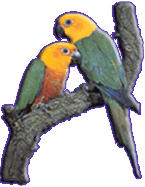|
|
| |
|
|
|
|
RED-FRONTED PARAKEET
Cyanoramphus Novaezelandiae |
|
|
| |
| With it's cousin, the Yellow-fronted parakeet, this is the most widely spread species and the most popular parrot in New Zealand . This bird is very grace, tame, curious and peaceful. Male and female are of the same color – fluorescent green – with red forehead and a red line that goes from the forehead to the eye and a bit behind the eye. Difference in sexes can be spotted only by aviculturists with experience, and is present in the size and the shape of the head as well as in the width of the black upper mandible in its root, just below the cere. All this is slightly bigger with the male. Both sexes make sounds that are similar to bleating of the young goat, and that is the reason why this parrot is known as the “goaty” among the breeders. Despite the comparison to bleating, this sound is very cute and not noisy at all. The red- fronted parakeet is about 27 cm long.
|
|
|
Like many other species of parrots, the red-fronted parakeet was also the subject of experiment aimed in obtaining specimens of different and new colors. As a result of mutations we now have yellow, blue, white and gray red – fronted parakeets. All this mutations, except the yellow one, are very rare in our country due to very high prices.
|
|
Normal (green)
“goaty” |
yellow goaty
|
|
Red – fronted parakeet raise its young with success, and young birds are easily tamed. Parrot as a pet, can be kept as a single bird, but then it becomes a real “menace”, meaning that it becomes very devoted to its owner. Soon after releasing from the cage it starts to unbutton wardrobe, to unlace the shoes, to eat out of hand, plate etc. Of course, you can expect this kind of pet behavior only if you get yourself a young bird (goes for all other species of parrots). When it comes to devotion to the owner, red – fronted parakeet is on the top of the list. It spends a great deal of time on the ground or floor, so if you are planning to breed them don't waste your time on providing many branches/perches for standing in the voliere/aviary. Its strong tarsus enables them to climb up the wire of the aviary or cage without using their wings. When living in nature, it rummages the ground for food by his feet, in a chicken – like manner.
|
|
|
|
This parrot loves to rummage, but it feeds by holding peaces of fruit and vegetable by leg instead of pecking from the ground. Although being a bird from New Zealand , it easily acclimatizes to a very warm weather or to cold, European winters. It nests in nestboxes that are 20x30cm in the base and 35cm high, with a hole of 7cm in diameter. Female lays 4-9 eggs and incubates them for 19-21 days. The young stay in the nest for next 5 weeks after hatching, and are fed by female. The diet consists of halfdigested food which male gives to female. Young birds stay with their parents for 2-3 weeks after leaving the nest, and after that period they become independent.
They can mate after 5 months, when they become reproductive.
|
| |
|
|
Red – fronted parakeet has almost the same diet as all other medium size parrots which consists of millet seed, oats, sunflower, canary seed, hemp, sorghum, bar – millet and of course apple, carrot and spinach, which they eat by holding it in their feet. Cabbage should be avoided in diet for all species of parrots, although they would eat it, because it could cause diarrhea and even dysentery, that can be fatal for the bird. As in diet of other parrot species, it is favorable to feed the young with a soft food mix that consists of eggs, cookies and ungrinded blue poppy or toast soaked in milk.
Having in mind that the most of the time it spends on the floor or ground from which it eats, it is important to say that they frequently develop digestive tract parasites. If that is the case, the bird should be given some of the antiparasitic digestive tract medicines, recommended by breeders, because among other things, bird's age play important role. Life expectancy is about 30 years. As pets, they rarely develop parasitic infection because they eat in clean cages and not from the ground which is the case when living in the wild.
|
|
|
| |
|
Unfortunately, it needs to be said that number of this birds is fairly reduced in their natural habitat, by farmers and natives, so it is our responsibility as breeders and aviculturists to save this species from extinction. It is up on us to breed them so that in the future they could amuse us with their great curiosity and devotion, making our homes and, specially, children happy.
|
| |
|
|
| |
|
|
|
|
|
|
|
|
|

